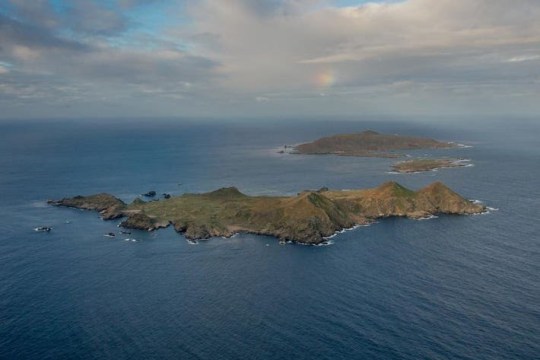Biología| Amante de las tormentas| Surf| Jazz| Box| Astronomía| Senderismo| Fotografía| Psicología| Comportamiento animal| Ecología evolutiva| Desarrollo Sustentable |Conservación
Don't wanna be here? Send us removal request.
Text
Se extraña la esencia de lo que fuimos entre la cólera del tiempo y recuerdos de días nublados.
0 notes
Text


Mexican biologist Yuliana Bedolla
Off Mexico's west coast, the Baja California Pacific Islands are key global nesting sites for 23 seabird species and Natividad Island shelters 90 percent of the breeding population of the Black-vented Shearwater (Puffinus opisthomelas).
Mexican conservation biologist Yuliana Rocío Bedolla Guzmán, Director of the Marine Birds Project at Grupo de Ecología y Conservación de Islas (GECI) says that invasive mammals like cats and rats wiped out at least 27 seabird colonies in the past.
The researchers have been working with fishing cooperatives to decrease the likelihood of reintroductions that would lead to expensive eradication efforts.
"In 2021, we created the local community group “Líderes Comunitarios'' formed by enthusiastic and committed women who have received formal training on island biosecurity and bird identification, and are becoming agents of change in their communities," Bedolla says.
Recently, Bedolla won a 2023 Whitley Award from UK charity Whitley Fund for Nature (WFN) and will use the funding to boost the role of local women and fishing cooperative.
"The goal is to continue preventing the accidental introduction of invasive mammals on Natividad and San Benito Oeste islands by actively involving local leaders and fishing cooperatives in biosecurity protocols," she says.
"My Grain of Sand"
Bedolla grew up far from the sea in Moroleón, a small town in central Mexico, where she enjoyed being out in nature.
"But I had my Eureka moment when I learned to snorkel when I was 12 years old at a beach in Zihuatanejo, Guerrero, in the Mexican Pacific," she says adding that she remembered a feeling of amazement, wonder and a new sense of connection to nature.
"That experience was life-changing for me and marked the beginning of my journey as a conservationist," Bedolla says, "From that moment on, I knew I wanted to become a marine biologist and contribute with my grain of sand."
She would go on to study Marine Biology at the Universidad Autónoma de Baja California Sur in La Paz, Baja California Sur, Mexico, learning to dive and study coral reefs and associated invertebrates on several islands in the Gulf of California.
Bedolla would contact GECI in the course of her masters degree and years later, after a Phd in Germany, GECI offered her the directorship of the Marine Birds Project.
Bedolla says that being from the Global South helps her to bring diverse perspectives and approaches to scientific research, which can lead to more innovative and creative solutions.

The San Benito Islands, which is among the islands Yuliana Bedolla is trying to protect from invasive species
Yuliana is a marine biologist, graduated with honors from the Autonomous University of Baja California Sur (UABCS).
She is a Master in Coastal Oceanography from the Autonomous University of Baja California (UABC) and a PhD candidate from the Justus Liebig University of Giessen in Germany. For her doctorate, she obtained a scholarship in Germany. Yuliana speaks Spanish and English and has basic knowledge of the German language. Her doctoral research focuses on the foraging ecology of three petrel species that nest in the San Benito Archipelago, in the Pacific of Baja California.
She began collaborating with the Ecology and Conservation of Islands Group, A.C., (GECI), in 2009 as a field biologist, and is currently the director of the Seabird Project, which aims to restore and conserve seabirds through the use of social attraction systems in conjunction with systematic monitoring, research and environmental education. She has carried out numerous research studies with national and international institutions. Her scientific publications in international journals focus on the response of seabirds to environmental conditions, the parasites that infect seabirds and the response of native fauna to the eradication of invasive mammals.
She has collaborated with several national seabird conservation programs and has been directly involved in environmental restoration projects in Isla Isabel, San Benito Archipelago, Banco Chinchorro and Arrecife Alacranes, related to the eradication of invasive rodents for the benefit of seabird colonies, among other island species. Her activities at GECI include project planning, staff coordination and supervision, applied research and monitoring, environmental education with local communities and dissemination of information in conferences and scientific reports and publications.
Source
35 notes
·
View notes
Text

"La naturaleza no es un lugar para visitar, es el hogar". Nature is not a place to visit. It's home.
0 notes
Text
Saving seabirds from an island invasion!

Brown footed boobies stand watch at Johnston Atoll NWR. Photo credit: L. Hayes/USFWS
Johnston Atoll National Wildlife Refuge is 750,000 square miles from anywhere. In the middle of the Pacific Ocean, this collection of four islands – the biggest being 640 acres – provides one of the only rat free, safe nesting places for seabirds and shorebirds in the Pacific Remote Islands.

Greater frigate bird and chick in their nest on Johnston Atoll NWR. Photo credit: Laura Beauregard/USFWS
That is until the yellow crazy ants invaded.
Likely brought to the island by humans, yellow crazy ants (Anoplolepis gracilipes), are highly mobile and can easily become established and dominant in a new habitat. A hardy survivor, the yellow crazy ant is part of a group of ants known as tramp ants. Their range is primarily limited by how far they can travel and hitching a ride with humans takes them to places unprepared for such mighty invaders. Places like Johnston Atoll NWR. The yellow crazy ants quickly took over at the island of Johnston Atoll and wreaked havoc on the thousands of nesting seabirds.
Keep reading
12 notes
·
View notes
Video
tumblr
The sounds a cheetah makes when receiving a massage | source
4K notes
·
View notes
Photo

Pareja de Carpinteros Cheje (Melanerpes aurifrons), preparando el nido para la temporada de reproducción. #pajarocarpintero #birds #aves #nature #woodpecker #bird #naturephotography #birdwatching #wildlifephotography #carpintero #woodpeckers #birdphotography #birding (en Xcalak, Quintana Roo) https://www.instagram.com/p/CoYhqnYMdFaEQ2Y6f6yip8-CFNiQRzrtbzEBJc0/?igshid=NGJjMDIxMWI=
#pajarocarpintero#birds#aves#nature#woodpecker#bird#naturephotography#birdwatching#wildlifephotography#carpintero#woodpeckers#birdphotography#birding
6 notes
·
View notes
Photo

Atardecer en el Caribe Mexicano.
Sunset in the Mexican Caribbean.
#Caribe #Sunset #Caribbean #BancoChinchorro
6 notes
·
View notes
Photo

Cayo Centro, Reserva de la Biosfera Banco Chinchorro, Quintana Roo, México.
06/01/2021
@David Alberto Macías Díaz
#sun#cloud#sky#ocean#sea#island#sea waves#waves#lake#sundown#sunrise#landscape#photography#adventure#explore#travel#traveling#nature#paradise#indie#hipster#vintage#retro
13 notes
·
View notes
Quote
Nadie prefiere el sitio, sin embargo, probamos ecosistemas donde podamos percibir condiciones idóneas para nuestra existencia y tenga los recursos suficientes para nuestra descendencia aun sabiendo los riesgos que implica; nadie elige el momento, sin embargo, a cada instante pensamos en experiencias del pasado y modelamos el futuro; nadie decide la edad, sin embargo, el ambiente donde nos exponemos nos genera problemas que debemos resolver con la intención de crecer y reproducirnos; nadie elige el amor, sin embargo, intentamos obtener el tipo de feromonas y hormonas compatibles con nuestros receptores que nos hagan sentir bien; nadie escoge a la persona, sin embargo, seleccionamos a la potencial pareja con la que podamos preservar nuestros genes y con el que se pueda compartir, sitios, momentos y amor sin importar la edad.
DAVID A. MACIAS
1 note
·
View note
Video
The full rotation of the Moon as seen by NASA’s Lunar Reconnaissance Orbiter.
553K notes
·
View notes
Text
“Si me ves por alguno de tus pensamientos, abrazame que te extraño".
-Julio Cortázar
0 notes














